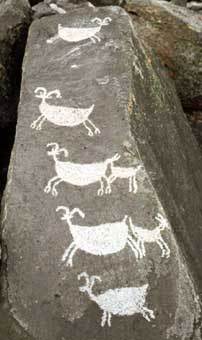Coso Rock Art District | |
 Bighorn sheep, a characteristic design at Coso | |
| Location | Mojave Desert, Coso Range, Big and Little Petroglyph Canyons |
|---|---|
| Nearest city | China Lake, California |
| NRHP reference No. | 99001178[1] |
| Significant dates | |
| Added to NRHP | October 8, 1999[1] |
| Designated NHLD | July 8, 2001[2] |
Coso Rock Art District is a rock art site containing over 100,000 Petroglyphs by Paleo-Indians and/or Native Americans.[1] The district is located near the towns of China Lake and Ridgecrest, California. Big and Little Petroglyph Canyons were declared a National Historic Landmark in 1964. In 2001, they were incorporated into this larger National Historic Landmark District.[2] There are several other distinct canyons in the Coso Rock Art District besides the Big and Little Petroglyph Canyons. Also known as Little Petroglyph Canyon and Sand Tanks, Renegade Canyon is but one of several major canyons in the Coso Range, each hosting thousands of petroglyphs (other locations include Haiwee Springs, Dead End Canyon, and Sheep Canyon). The majority of the Coso Range images fall into one of six categories: bighorn sheep, entopic images, anthropomorphic or human-like figures (including animal-human figures known as pattern-bodied anthropomorphs), other animals, weapons & tools, and "medicine bag" images. Scholars have proposed a few potential interpretations of this rock art. The most prevalent of these interpretations is that they could have been used for rituals associated with hunting.[3]
Most of the Coso Range is on the Naval Air Weapons Station China Lake, where visitation is restricted, vandalism is low, and preservation is most likely. The Coso Range is between the Sierra Nevada and the Argus Range. Indian Wells Valley lies to the south of this location. This north-south trending range of about 400 square miles (1,000 km2) consists of rhyolitic domes and outcrops of volcanic rock. The most popular subjects are bighorn sheep, deer, and antelope.[citation needed]
A November 2007 Los Angeles Times' Travel feature article includes it within a top 15 list of California places to visit.[4] The area was also mentioned in Groupon's "10 Most Unique Autumn Festivals in the Country"[5] as a part of the Ridgecrest Petroglyph Festival.
- ^ a b c "National Register Information System". National Register of Historic Places. National Park Service. July 9, 2010.
- ^ a b "Coso Rock Art District". National Historic Landmark summary listing. National Park Service. Archived from the original on October 8, 2012. Retrieved November 17, 2007.
- ^ Robinson, David W. (2010). "LAND USE, LAND IDEOLOGY: AN INTEGRATED GEOGRAPHIC INFORMATION SYSTEMS ANALYSIS OF ROCK ART WITHIN SOUTH-CENTRAL CALIFORNIA". American Antiquity. 75 (4): 792–818. ISSN 0002-7316.
- ^ Susan Spano (November 15, 2007). "10. Mojave Art on the Rocks, in "THE GOLDEN 15: 15 places to visit to see the real California"". Los Angeles Times.
- ^ "Fall Festivals: The 10 Most Unusual Fests Across the Country". Groupon. Retrieved September 2, 2015.

